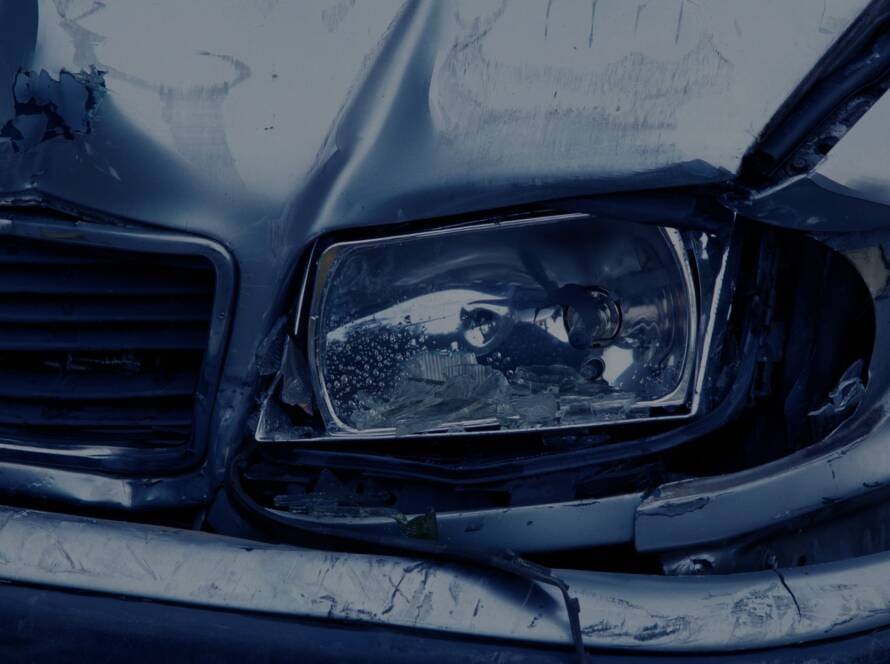Unraveling the Complexities of Uber Accident Lawsuits: What You Need to Know
In 2022, Uber reported 3,824 sexual assaults and 20 fatalities from 2019-2020. These numbers hit me hard. As someone who frequently uses rideshare services, I realized how crucial it is to understand the legal implications of Uber accidents. Let’s dive into the intricate world of Uber accident lawsuits and equip you with essential knowledge to navigate this complex terrain.
The Evolving Legal Terrain of Uber Accidents
The legal landscape surrounding Uber accidents is in constant flux. Rideshare services have revolutionized urban transportation, but they’ve also created unique challenges for accident-related lawsuits. These cases often involve complexities not seen in traditional auto accident claims, demanding a deep understanding of both transportation and technology law.
Rideshare services operate under a different legal framework than traditional taxi services, significantly impacting liability determinations. This distinction is crucial when building a case or defending against one. The rapid evolution of rideshare technology and business models necessitates frequent updates to legal strategies, keeping attorneys on their toes.
Did you know that non-injured car accident victims received an average settlement of $16,700, while injured car accident victims received an average of $29,700? These figures provide a baseline, but Uber accidents often involve additional factors that can influence settlement amounts.
A recent case in New Jersey highlights how Uber’s terms of service can prevent customers from suing the company, even for unrelated incidents. This “Uber’s Terms of Service Trap,” as reported by Balls and Strikes, underscores the importance of understanding the fine print when using rideshare services.

Source: lordandkobrin.com
Dual Insurance Complexities
Uber’s insurance structure creates a layered system that can complicate claims. Understanding when and how Uber’s insurance applies is crucial for any lawsuit. The coverage can vary dramatically depending on the driver’s status at the time of the accident, creating potential gaps that can affect your claim.
Uber’s insurance policy typically provides up to $1 million in liability coverage when the driver is actively transporting a passenger. However, this coverage isn’t always straightforward. The limits and applicability change based on whether the driver is waiting for a ride request, en route to pick up a passenger, or offline.
In some cases, the driver’s personal auto insurance may need to be involved, adding another layer of complexity to the claim process. This interplay between personal and commercial insurance can be a significant hurdle in Uber accident cases.
| Driver Status | Insurance Coverage |
|---|---|
| Offline | Driver’s personal insurance |
| App on, waiting for request | Uber’s limited liability coverage |
| En route to pickup or during trip | Uber’s full $1 million liability coverage |
I recently came across a case where an Uber passenger was injured when their driver ran a red light. The passenger’s claim was complicated because the driver had just dropped off another passenger and was waiting for a new request. This “in-between” status led to a dispute over which insurance policy should apply. It’s a perfect example of how the nuances of Uber’s insurance structure can impact real-world cases.
The “App On” Conundrum
The status of the Uber app at the time of the accident significantly impacts insurance coverage and liability. This nuanced detail can make or break a case. It’s not just about whether the driver was working for Uber, but exactly what stage of the process they were in when the accident occurred.
When the app is on but the driver hasn’t accepted a ride, Uber provides limited liability coverage. Once a ride is accepted, higher coverage limits apply, even if the passenger hasn’t been picked up yet. This distinction can be crucial in determining the extent of available compensation.
Determining the exact app status at the time of the accident often requires detailed digital forensics. This process can be complex and time-consuming, but it’s often necessary to establish the full picture of liability and available insurance coverage.
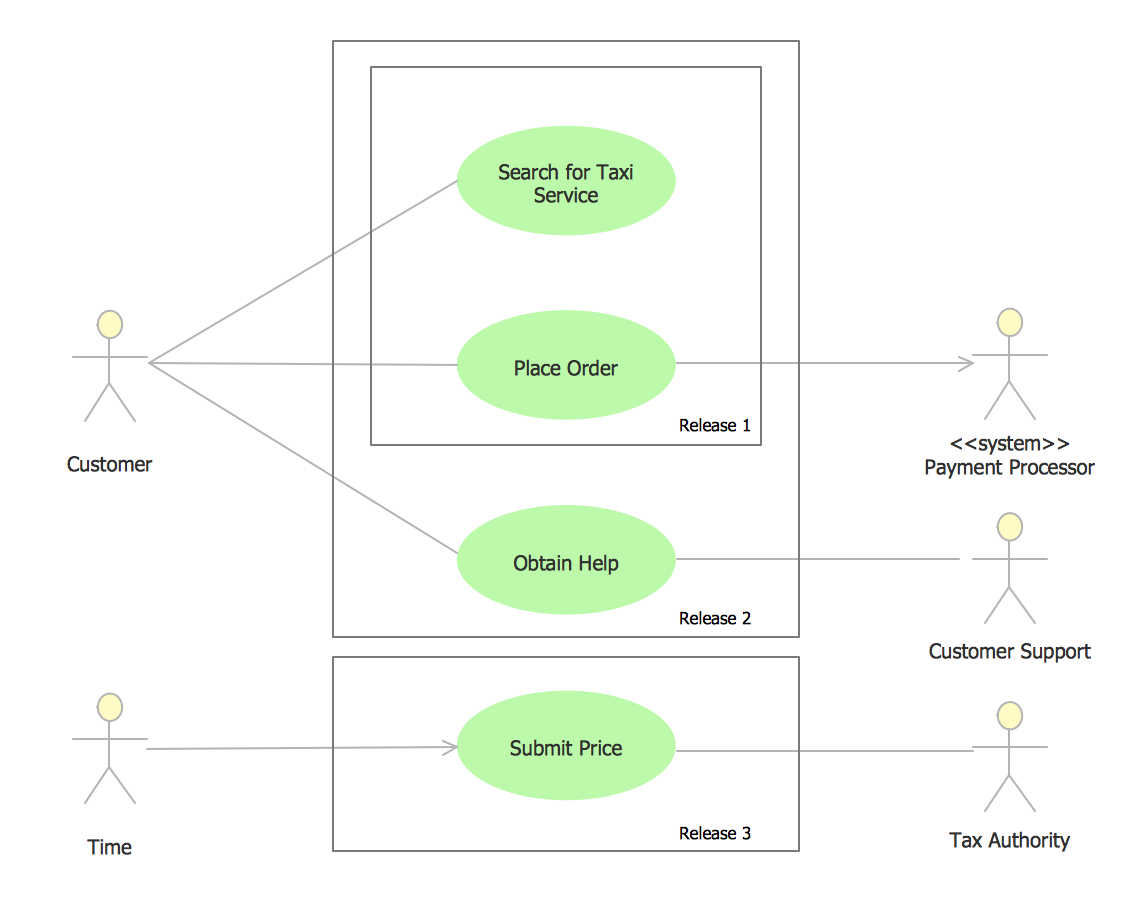
Source: conceptdraw.com
Third-Party Liability Considerations
In some Uber accident cases, entities beyond Uber and the driver may share liability. This could include vehicle manufacturers, road maintenance authorities, or even other drivers involved in the accident. Identifying all potentially liable parties is crucial for maximizing your chances of full compensation.
Product liability claims may be relevant if vehicle defects contributed to the accident. For instance, if a faulty brake system played a role in the crash, the vehicle manufacturer could be held partially responsible. Similarly, government entities responsible for road maintenance could be liable if poor road conditions played a role in the accident.
In multi-vehicle accidents, determining the proportion of fault for each party becomes crucial. This process often involves complex negotiations and may require expert testimony to establish the sequence of events and each party’s role in the accident.
Video Source: YouTube
Navigating Independent Contractor Status
Uber’s classification of drivers as independent contractors presents unique challenges in establishing liability and pursuing damages. This status can affect everything from insurance coverage to the types of claims you can make against Uber itself.
The independent contractor status limits Uber’s direct liability for driver actions in many cases. This classification can be a significant hurdle for plaintiffs seeking to hold Uber accountable for driver behavior. It’s a contentious issue that’s been the subject of numerous legal battles across the country.
This classification also affects workers’ compensation claims, as drivers typically aren’t eligible for traditional employee benefits. In the event of an accident, this can leave drivers in a precarious position, potentially without access to important protections and benefits.
Recent legal challenges to this classification in some jurisdictions could potentially alter the liability landscape. A historic settlement resulted in Uber agreeing to pay $290 million into a settlement fund to be distributed to current and former drivers as a result of a $328 million wage-theft settlement. This development highlights the ongoing debate over driver classification and its implications for accident liability.
![INFOGRAPHIC] How to Classify Independent Contractors Correctly ...](https://www.nextep.com/wp-content/uploads/2023/08/Nextep-Infographic-Employee-vs-Independent-Contractor-2.png)
Source: nextep.com
Vicarious Liability Arguments
Despite the independent contractor status, there may be grounds to argue for Uber’s vicarious liability in certain circumstances. This legal theory suggests that Uber could be held responsible for the actions of its drivers under specific conditions, even if they’re not traditional employees.
Courts may consider factors like the level of control Uber exerts over drivers when determining vicarious liability. The more control Uber has over driver behavior and operations, the stronger the argument for vicarious liability becomes. This can include aspects like setting fares, dictating routes, and enforcing performance standards.
Some jurisdictions have established precedents holding rideshare companies liable for driver actions in certain situations. These rulings can provide valuable ammunition for plaintiffs seeking to hold Uber accountable for accidents involving their drivers.
Successful vicarious liability arguments often hinge on demonstrating that the driver was acting within the scope of their relationship with Uber. This can be a complex legal argument, requiring careful analysis of the specific circumstances of each case.
In a landmark case, a court found Uber vicariously liable for a driver’s actions because the company’s app directed the driver’s route and set the fare, demonstrating a level of control typically associated with an employer-employee relationship. This ruling opened up new avenues for holding rideshare companies accountable for driver actions.
For more information on how vicarious liability can impact rideshare accident cases, see our guide on navigating complex commercial vehicle accidents.
Technology’s Role in Uber Accident Cases
The technological infrastructure behind Uber’s service provides both challenges and opportunities in accident lawsuits. Understanding how to leverage this technology can be crucial to building a strong case.
Uber’s digital platform generates vast amounts of data that can be used as evidence in accident cases. This data can include everything from GPS locations to driver ratings and trip histories. It’s a goldmine of information that can provide objective evidence to support or refute claims.
Technological evidence can often provide more objective information than eyewitness accounts. In the heat of the moment, memories can be unreliable, but data doesn’t lie. This makes technological evidence a powerful tool in reconstructing the events leading up to an accident.
A recent case highlighted the importance of understanding Uber’s digital infrastructure. A New Jersey couple was prevented from suing Uber after a serious accident due to the company’s digital terms of service agreement. This “Uber’s Digital Agreement Blocks Lawsuit” case, as reported by Fox Business, underscores the need for users to be aware of the digital agreements they’re entering into when using rideshare services.
Data as Evidence
Uber’s extensive data collection can provide crucial evidence in accident cases, but accessing and interpreting this data presents unique challenges. From GPS locations to driver ratings, this digital information can paint a detailed picture of the circumstances surrounding an accident.
Uber collects data on driver behavior, including acceleration, braking, and speed. This information can be invaluable in reconstructing the events leading up to an accident. For example, sudden acceleration or hard braking just before a collision could indicate driver error or an attempt to avoid a hazard.
Timestamps from the app can help establish the exact sequence of events leading up to an accident. This precision can be crucial in determining liability, especially in cases where the timing of events is disputed.
Accessing this data often requires legal action, as Uber typically doesn’t release it voluntarily. This can involve subpoenas or court orders, adding another layer of complexity to the legal process. It’s a hurdle that underscores the importance of working with attorneys experienced in handling rideshare accident cases.
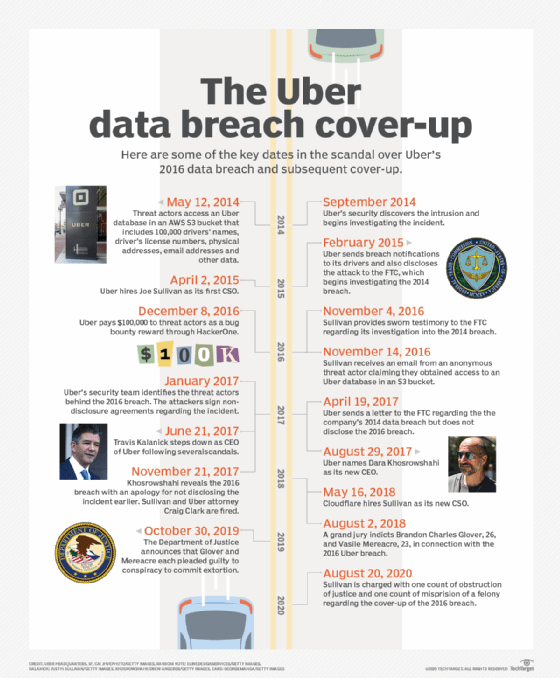
Source: techtarget.com
GPS and Telemetry Analysis
Advanced analysis of GPS and telemetry data can reconstruct accident scenarios with unprecedented detail. This technical evidence can be particularly powerful in cases where there are conflicting accounts of what happened.
GPS data can pinpoint the exact location and movement of the vehicle leading up to the accident. This information can be crucial in determining factors like speed, direction of travel, and whether the driver was following the designated route.
Telemetry data can reveal information about the vehicle’s speed, direction, and even sudden movements. This can help establish whether the driver was operating the vehicle safely and responsibly at the time of the accident.
Expert analysis is often required to interpret this data and present it effectively in court. This might involve data scientists, accident reconstruction specialists, or other technical experts who can translate complex data into clear, compelling evidence.
I recently worked on a case where GPS data contradicted the driver’s account of the incident. The data showed that the driver was traveling 20 mph over the speed limit just before the collision, which was crucial in establishing liability. It’s a perfect example of how technological evidence can cut through conflicting testimonies and provide objective facts.
App Interface and User Experience Considerations
The design and functionality of Uber’s app may be scrutinized for its potential role in driver distraction or other safety concerns. How drivers interact with the app while operating their vehicle can be a crucial factor in accident cases.
The app’s user interface design can be analyzed for potential distraction risks. Features like pop-up notifications, complex navigation instructions, or frequent updates could potentially divert a driver’s attention from the road.
Updates to the app over time may be relevant, especially if they’ve addressed previous safety concerns. This could include changes to reduce driver distraction or improve navigation accuracy. Tracking these updates and their potential impact on safety can be an important aspect of building a case.
Expert testimony on human-computer interaction may be necessary to establish how app usage contributed to an accident. This might involve usability experts or cognitive psychologists who can speak to the app’s potential impact on driver attention and behavior.

Source: medium.com
Algorithmic Dispatch and Its Legal Implications
Uber’s use of algorithms for driver dispatch and routing may introduce new factors in determining liability. The way these algorithms operate can affect driver behavior and potentially contribute to accident risk.
Algorithms determining driver assignments and routes can influence driver decisions and behavior. For example, if the algorithm consistently encourages drivers to take shorter but potentially more dangerous routes, it could be seen as contributing to accident risk.
The transparency (or lack thereof) of these algorithms can become a point of contention in legal proceedings. Uber’s proprietary algorithms are often treated as trade secrets, making it challenging for plaintiffs to fully understand how dispatch decisions are made.
Expert analysis may be required to determine if algorithmic decisions contributed to unsafe conditions. This might involve data scientists or AI experts who can examine the algorithm’s outputs and assess their potential impact on driver behavior and safety.
It’s worth noting that more than 100,000 reported accidents are linked to ridesharing each year. This staggering number highlights the scale of the issue and the potential impact of algorithmic dispatch on safety. It’s a sobering reminder of the real-world consequences of the decisions made by these complex systems.
Fatigue and Overwork Arguments
Analyzing app data to build cases around driver fatigue due to long hours encouraged by Uber’s algorithms is becoming increasingly common. This approach looks at how Uber’s system might incentivize drivers to work extended hours, potentially increasing accident risk.
Data on driver hours and patterns can be used to establish potential fatigue-related risks. For instance, if a driver has been active on the app for an unusually long period before an accident, it could support arguments about fatigue-induced errors.
Incentive structures within the app may be scrutinized for their role in encouraging overwork. Bonuses for completing a certain number of rides within a set timeframe, for example, could be seen as pushing drivers to stay on the road longer than is safe.
Comparisons with regulations in other industries (like trucking) regarding work hours may be relevant. While rideshare drivers aren’t subject to the same strict hour limits as commercial truck drivers, these regulations can provide a benchmark for what’s considered safe in terms of consecutive driving hours.
Peak hour pricingPeak hour pricing can motivate drivers to work during high-stress periods, potentially increasing fatigue and accident risk. This surge pricing model, while beneficial for meeting demand, may inadvertently encourage unsafe driving practices. To learn more about how driver fatigue can impact accident cases, check out our article on the dangers of head-on collisions, which often involve fatigued drivers.
Global Precedents and Their Impact
As a multinational company, Uber faces legal challenges worldwide. Examining how global precedents and rulings may influence U.S. Uber accident lawsuits can provide valuable insights and potential strategies. Legal decisions in other countries can sometimes be cited in U.S. cases, especially if they address similar issues. While not binding, these international rulings can offer persuasive arguments or novel approaches to complex legal questions. Global rulings can influence Uber’s policies and practices worldwide, potentially affecting U.S. operations. For instance, a significant ruling in Europe might prompt Uber to adjust its practices globally to avoid similar legal challenges in other markets.
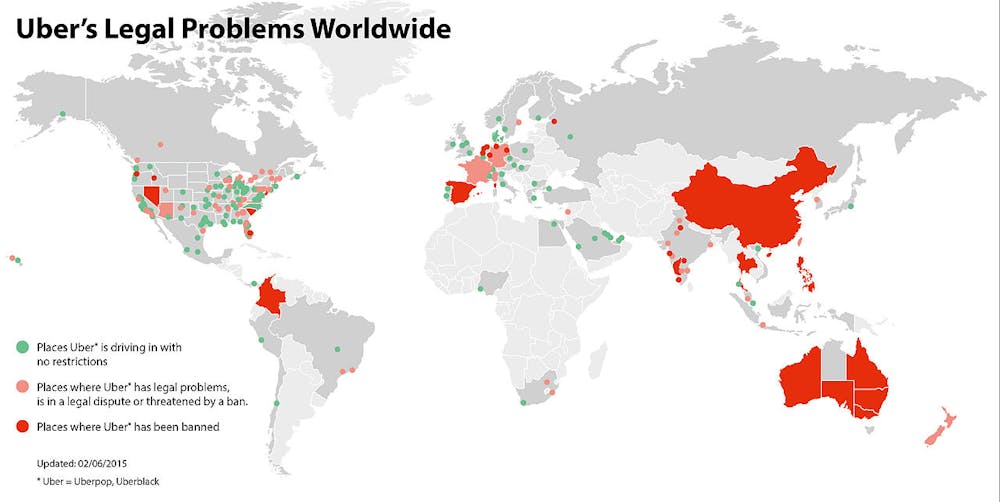
Source: theconversation.com
Cross-Jurisdictional Legal Strategies
Lawyers may draw on successful strategies and rulings from other countries to strengthen their cases in the U.S. This global perspective can provide innovative approaches to challenging legal issues in Uber accident cases. Legal arguments that have been successful in other countries may be adapted for U.S. courts. For example, a novel approach to establishing vicarious liability in a European case might inspire similar arguments in U.S. lawsuits. International rulings can sometimes set precedents that influence U.S. judges, especially in novel legal areas. The global nature of rideshare services means that courts are often grappling with similar issues across different jurisdictions. Comparative analysis of rideshare regulations across countries can provide context for U.S. cases. Understanding how other nations have addressed similar challenges can offer valuable insights into potential regulatory and legal approaches.
Regulatory Adaptation Precedents
How Uber’s responses to regulatory challenges abroad might be leveraged in U.S. lawsuits is an important consideration. The company’s history of adapting to different regulatory environments can provide insights into their potential responses in U.S. cases. Uber’s compliance measures in stricter regulatory environments may be used to argue for higher standards in the U.S. If Uber has implemented more robust safety measures in other countries, plaintiffs might argue that similar protections should be in place domestically. The company’s history of challenging or adapting to regulations can be relevant in determining their approach to U.S. cases. Uber’s track record of legal battles and regulatory negotiations worldwide can offer clues about their likely strategies in domestic lawsuits. Regulatory changes prompted by Uber’s operations in other countries may foreshadow potential developments in the U.S. Keeping an eye on global regulatory trends can help attorneys anticipate future legal challenges and opportunities.
The Ripple Effect of International Settlements
Large settlements or verdicts against Uber in other countries may influence negotiation strategies and settlement expectations in U.S. cases. Understanding this global context can be crucial in developing effective legal strategies. High-value settlements in other countries can set benchmarks for negotiations in U.S. cases. While not directly applicable, these international settlements can shape perceptions of what constitutes fair compensation in Uber accident cases. Uber’s global legal strategies and risk management approaches may be influenced by significant international cases. A major loss in one jurisdiction might prompt the company to take a more conciliatory approach in similar cases elsewhere. The financial impact of international settlements on Uber may affect their approach to U.S. litigation. If the company faces substantial payouts globally, it might become more inclined to settle U.S. cases to avoid further financial strain.
The Settlement Landscape
While many focus on courtroom battles, a significant number of Uber accident cases are resolved through settlements. Understanding the nuanced factors that influence Uber accident settlements is crucial for anyone involved in such a case. Settlement amounts can vary widely based on factors like injury severity, liability clarity, and jurisdiction. Each case is unique, and settlement values reflect the specific circumstances and potential risks of going to trial. The confidential nature of many settlements can make it challenging to establish clear precedents. This lack of transparency can sometimes work in favor of plaintiffs, as Uber may be willing to offer higher settlements to avoid public scrutiny.
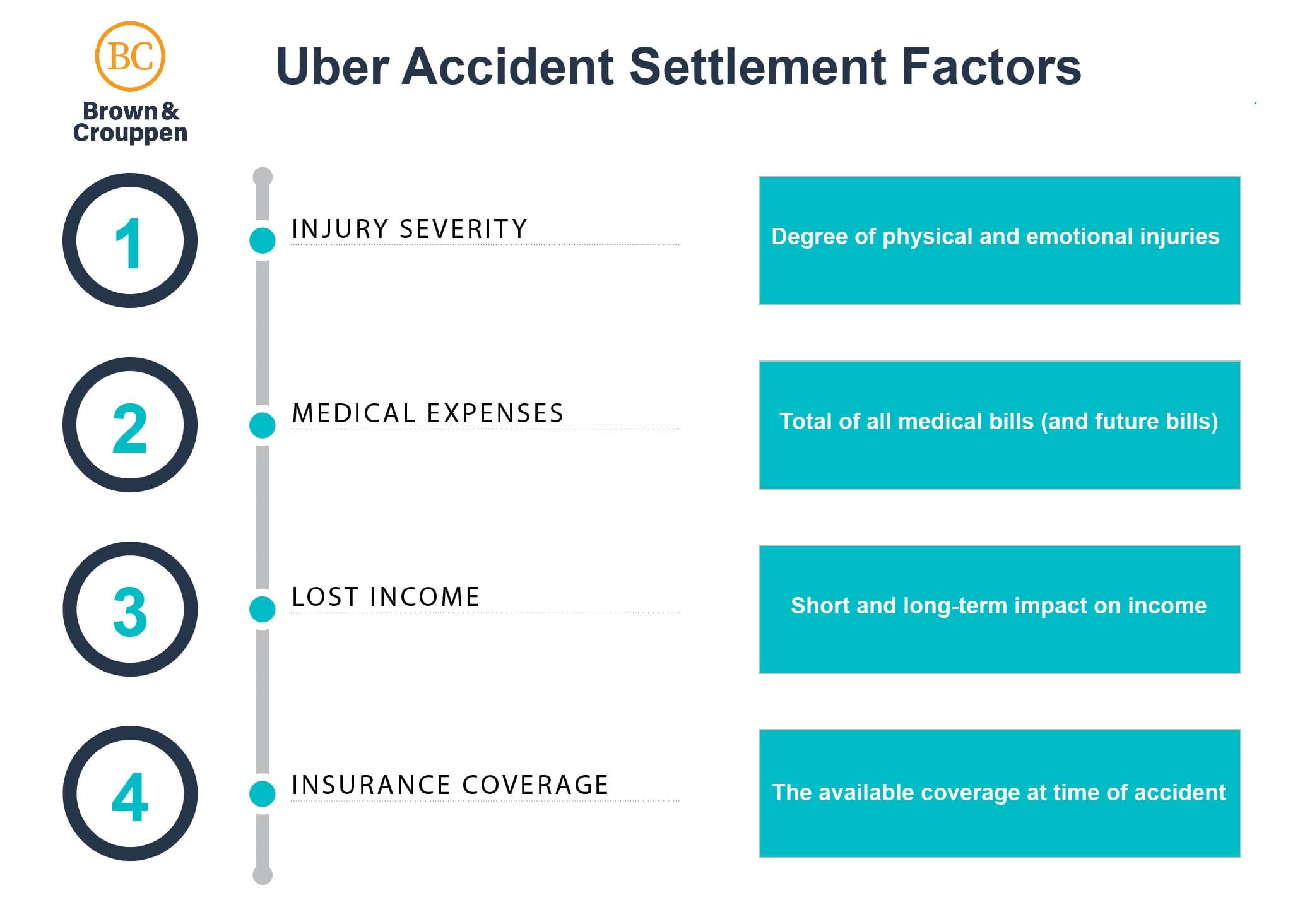
Source: brownandcrouppen.com
Reputation Management Considerations
Uber’s approach to settlements may be influenced by broader reputation management strategies, potentially affecting individual case outcomes. The company’s concern for public perception can play a significant role in how they handle accident claims. High-profile cases may be handled differently due to potential media coverage and public opinion impact. Uber might be more inclined to settle quickly or offer higher amounts in cases that risk negative publicity. Uber’s overall brand strategy can influence their willingness to settle or fight certain types of claims. The company might take a harder line on cases they believe could set unfavorable precedents, while being more amenable to settlement in others. The company’s history of handling similar cases can provide insights into their likely approach. Patterns in Uber’s past settlement behaviors can offer clues about how they might handle future cases.
Media Scrutiny and Public Perception
High-profile cases may be treated differently due to concerns about media coverage and public opinion. Understanding how media attention can influence case outcomes is important for both plaintiffs and their legal representatives. Media coverage can increase pressure on Uber to settle quickly or offer higher settlements. The threat of negative publicity might motivate the company to resolve cases more favorably for plaintiffs to avoid prolonged public attention. Public perception of the case can influence jury pools if the case goes to trial. Widespread media coverage can shape potential jurors’ opinions before they even enter the courtroom, potentially impacting the outcome of a trial. Social media reactions to accidents involving Uber can sometimes provide additional evidence or context. User-generated content like videos or eyewitness accounts shared on social platforms might be valuable in building a case or negotiating a settlement.
Comparative Analysis with Traditional Taxi Settlements
Understanding how Uber accident settlements compare to those involving traditional taxis can provide valuable context for negotiations. This comparison can help set realistic expectations and inform negotiation strategies. Differences in insurance structures between Uber and traditional taxis can affect settlement amounts. The layered insurance coverage of rideshare companies often results in higher potential payouts compared to traditional taxi accidents. The novelty of rideshare cases may lead to different settlement approaches compared to well-established taxi claim processes. The evolving legal landscape surrounding rideshare services can create opportunities for innovative legal arguments and settlement strategies. Precedents from taxi accident settlements may be used as reference points in Uber cases, with appropriate adjustments. While not directly applicable, these precedents can provide a baseline for understanding potential settlement ranges in rideshare cases.
Insurance Industry Adaptation
How the insurance industry’s evolving approach to rideshare coverage impacts settlement negotiations and outcomes is a crucial factor to consider. As insurers gain more experience with rideshare cases, their strategies and policies continue to evolve. New insurance products specifically designed for rideshare drivers can affect liability and settlement dynamics. These specialized policies may offer different coverage levels or terms that can influence settlement negotiations. Insurance companies’ risk assessments for rideshare-related claims continue to evolve, impacting settlement offers. As insurers gather more data on rideshare accidents, their approach to valuing and settling these claims may shift. The interplay between personal and commercial auto insurance in rideshare cases adds complexity to settlements. Navigating the boundaries between these different types of coverage can be challenging and may affect settlement strategies.
Emerging Trends in Uber Accident Litigation
As the rideshare industry evolves, so do the legal strategies and considerations in Uber accident lawsuits. Staying informed about these emerging trends is crucial for anyone involved in or considering an Uber accident lawsuit. The rapid evolution of rideshare technology necessitates ongoing updates to legal strategies. As Uber introduces new features or changes its operational model, legal approaches must adapt to address new potential liability issues. Emerging case law specific to rideshare accidents is shaping the legal landscape. Each new court decision adds to the body of precedent that guides future cases, gradually clarifying the legal standards applicable to rideshare accidents.
The Rise of Class Action Suits
Class action lawsuits against Uber are becoming more prevalent, addressing systemic issues that affect multiple plaintiffs. These large-scale suits can have significant impacts on Uber’s policies and practices. Class actions can address widespread issues like driver screening processes or app safety features. By consolidating multiple similar claims, these suits can potentially force broader changes in Uber’s operations. The outcomes of these suits can set important precedents for individual cases. A successful class action might establish liability principles or safety standards that can be applied in subsequent individual lawsuits. Class actions often involve complex legal procedures and longer timelines than individual suits. While potentially more impactful, these cases require significant resources and expertise to navigate effectively.
Safety Feature Inadequacies
Class actions focusing on alleged shortcomings in Uber’s safety features or driver screening processes are becoming more common. These cases often argue that Uber has a responsibility to implement more robust safety measures. Plaintiffs may argue that Uber’s safety features fall short of reasonable standards for passenger protection. This could include claims about inadequate emergency response systems, insufficient driver background checks, or lack of in-app safety features. The effectiveness of Uber’s driver background check process may be scrutinized. Class actions might challenge the thoroughness or frequency of these checks, arguing that more rigorous screening could prevent accidents or incidents. Expert testimony may be required to evaluate the adequacy of Uber’s safety protocols compared to industry standards. This might involve safety experts, technology specialists, or former transportation industry executives who can speak to best practices in passenger safety.
Discriminatory Practices Claims
Exploring how discrimination claims intersect with accident lawsuits, potentially strengthening individual cases. Allegations of discriminatory practices by Uber or its drivers can add another layer of complexity to accident cases. Discrimination claims may involve issues like driver selection of passengers or accessibility for disabled users. These claims can sometimes be linked to safety concerns, arguing that discriminatory practices increase accident risks for certain groups. Statistical analysis of accident rates and outcomes across different demographic groups may be used as evidence. This data-driven approach can help establish patterns of discrimination or disparate impact in Uber’s services. These claims may invoke additional legal protections beyond standard personal injury law. Anti-discrimination statutes or civil rights laws might come into play, potentially expanding the scope of liability and available remedies.
The Impact of Autonomous Vehicle Technology
As Uber invests in self-driving technology, new legal questions arise about liability in accidents involving autonomous or semi-autonomous vehicles. This emerging area of law presents unique challenges and considerations. Liability in autonomous vehicle accidents may shift more towards manufacturers and software developers. As human drivers play a diminishing role, the focus may turn to the technology itself and those responsible for its design and implementation. The role of human oversight in semi-autonomous systems introduces complex questions of responsibility. Determining liability when a human driver is present but not actively controlling the vehicle can be particularly challenging. Existing laws and regulations may need to be adapted to address the unique aspects of autonomous vehicle accidents. Lawmakers and courts are grappling with how to apply traditional liability concepts to these new technologies.
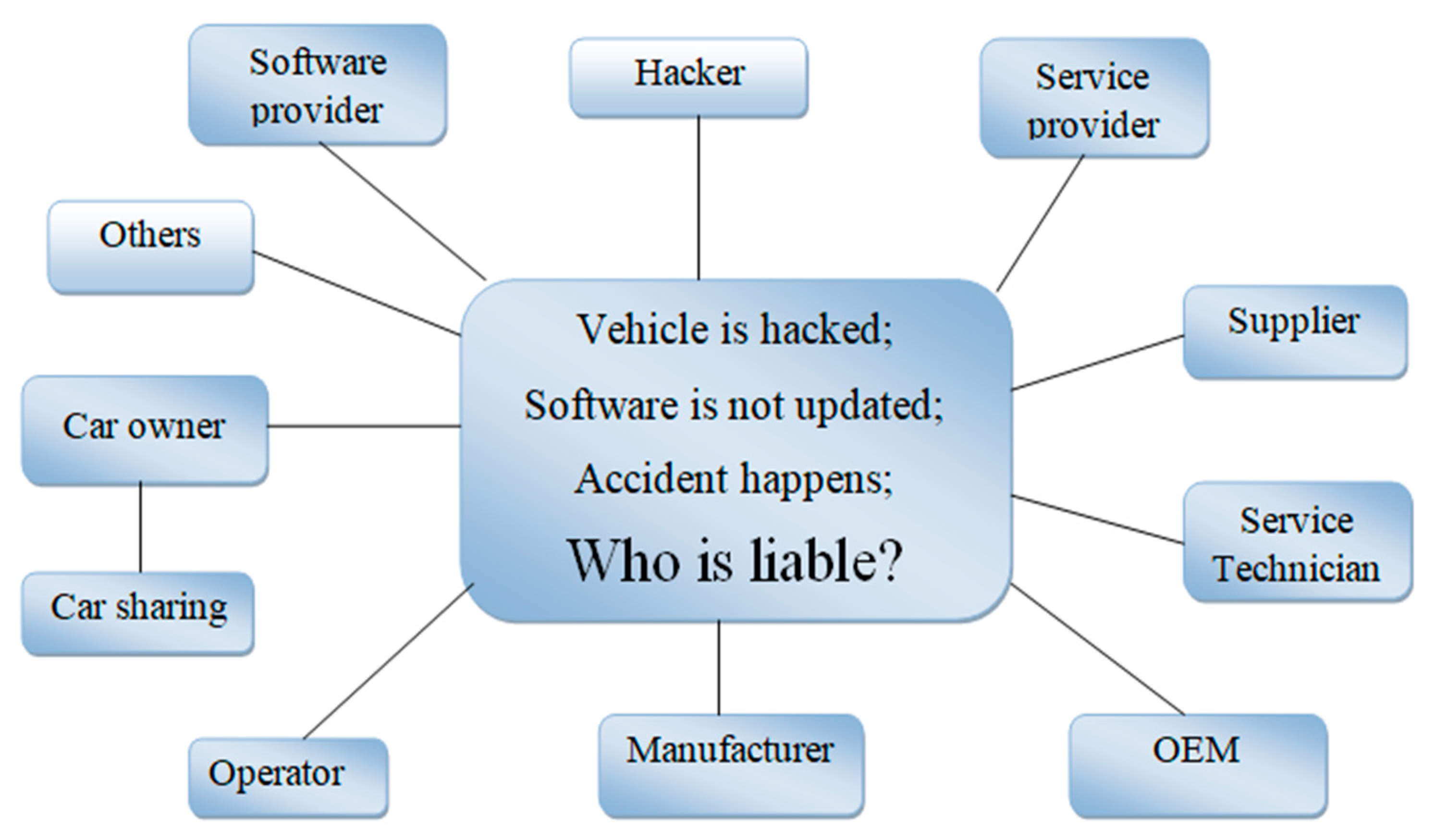
Source: mdpi.com
AI Decision-Making Scrutiny
Examining how courts may approach cases where AI decision-making played a role in an accident. As AI becomes more prevalent in vehicle systems, understanding its role in accidents becomes crucial. Courts may need to consider the “reasonableness” of AI decision-making compared to human standards. This could involve developing new legal tests to evaluate whether an AI system’s actions were appropriate given the circumstances. The transparency and explainability of AI systems may become key factors in determining liability. The ability to understand and explain how an AI system made a particular decision could be crucial in assigning responsibility for accidents. Expert testimony on AI and machine learning will likely play an increasing role in these cases. AI specialists, computer scientists, and ethicists might be called upon to explain complex technological concepts to judges and juries.
Gig Economy Labor Laws and Their Influence
Evolving labor laws related to gig economy workers may have significant implications for Uber accident lawsuits. Changes in how drivers are classified could dramatically alter the landscape of Uber accident liability. Shifts in driver classification from independent contractors to employees could expand Uber’s liability. If drivers are reclassified as employees, Uber might face greater responsibility for their actions under the principle of respondeat superior. New labor laws may affect drivers’ rights and benefits, potentially impacting accident claims. For instance, if drivers gain access to workers’ compensation benefits, it could change how some accident-related injuries are handled. The gig economy’s rapid growth is prompting legislative responses that could reshape the legal landscape. As lawmakers grapple with regulating this new form of work, the resulting laws could have far-reaching effects on rideshare accident liability.
Employee vs. Contractor Status Shifts
How changes in driver classification could dramatically alter the landscape of Uber accident liability. The ongoing debate over whether rideshare drivers should be classified as employees or independent contractors has significant legal implications. Employee classification could make Uber more directly liable for driver actions. This could potentially simplify some aspects of accident lawsuits by establishing a clearer line of responsibility. Changes in status could affect insurance coverage and claims processes. Employee status might require Uber to provide different types of insurance coverage, potentially expanding the resources available for accident victims. Labor law developments in this area could have retroactive effects on pending cases. Courts might need to grapple with how to apply new classifications to accidents that occurred under the previous system.
Strategic Considerations for Plaintiffs
Successfully navigating an Uber accident lawsuit requires a strategic approach that goes beyond traditional personal injury cases. Understanding key considerations and steps can significantly impact the outcome of your case. The complexity of Uber accident cases often requires specialized legal expertise. Attorneys familiar with the nuances of rideshare litigation can navigate the unique challenges these cases present more effectively. Building a strong case typically involves a multidisciplinary approach, combining legal, technical, and medical evidence. Coordinating these different aspects of the case can be crucial to presenting a compelling argument for compensation.
Building a Robust Digital Evidence Portfolio
Given the tech-centric nature of Uber’s service, gathering and preserving digital evidence is crucial. This evidence can provide objective data to support your case and challenge conflicting accounts. Digital evidence can include app data, GPS records, and communication logs. These digital footprints can offer a detailed timeline of events leading up to and following an accident. Preserving digital evidence quickly is crucial, as some data may be overwritten or deleted over time. Prompt action to secure this information can make a significant difference in the strength of a case. Expert analysis is often required to interpret complex digital evidence effectively. Technical experts can help translate raw data into compelling evidence that supports your claim.
Social Media Discovery Tactics
Leveraging social media and online presence of drivers and Uber to support claims can provide valuable insights and evidence. However, this approach must be handled carefully to ensure legal and ethical compliance. Social media posts by drivers or passengers may reveal crucial details about the incident. A driver’s post about working long hours, for example, could support arguments about fatigue-related negligence. Privacy settings and platform policies can affect the accessibility of social media data. Navigating these restrictions while staying within legal boundaries requires careful consideration and expertise. Ethical considerations come into play when using social media information in legal proceedings. Balancing the need for evidence with respect for privacy rights is a delicate task that requires thoughtful approach.
Forensic Data Analysis Partnerships
Collaborating with tech experts to extract and interpret complex data from Uber’s systems is often necessary. These partnerships can uncover critical evidence that might otherwise remain hidden. Forensic analysts can recover deleted data or access encrypted information relevant to the case. This specialized expertise can be invaluable in piecing together a comprehensive picture of the accident circumstances. Advanced data visualization techniques can help present complex technical evidence to juries effectively. Transforming raw data into clear, understandable visuals can significantly impact how jurors perceive and weigh the evidence. Partnerships with academic institutions or tech companies may provide access to cutting-edge analysis tools. These collaborations can bring sophisticated resources to bear on complex data analysis challenges.
Navigating Multi-Party Negotiations
Uber accident cases often involve multiple parties, requiring skilled negotiation tactics. You’ll need to navigate discussions with Uber, insurance companies, and potentially other involved parties. Multi-party negotiations often involve complex dynamics and competing interests. Understanding each party’s motivations and potential liability can help in crafting effective negotiation strategies. Understanding each party’s liability exposure and insurance coverage is crucial for effective negotiations. This knowledge can help in identifying potential settlement sources and assessing the strength of your position. Alternative dispute resolution methods like mediation may be useful in resolving multi-party cases. These approaches can offer more flexible and collaborative solutions than traditional litigation.
Identifying All Potential Defendants
Casting a wide net to ensure all liable parties are included in the lawsuit is a crucial strategy. This approach can increase the chances of full compensation and address all aspects of liability. Potential defendants might include Uber, the driver, vehicle manufacturers, or even local governments responsible for road conditions. Each of these entities may bear some responsibility for the accident, depending on the circumstances. Each defendant’s role in the accident must be carefully analyzed to establish liability. This process often involves detailed investigation and expert analysis to determine how various factors contributed to the incident. Adding defendants later in the process can be challenging, so thorough initial investigation is key. It’s essential to identify all potentially liable parties early to avoid complications or limitations later in the legal process. For more information on identifying potential defendants in complex accident cases, see our guide on maximizing settlements in premises liability cases.
Leveraging Media and Public Opinion
In high-profile cases, media strategy can play a significant role in pressuring Uber towards favorable settlements. However, this approach requires careful handling to avoid legal pitfalls. Media coverage can influence public perception and potentially impact jury pools. Strategic use of media can help shape the narrative around your case, potentially influencing settlement negotiations. Strategic use of press releases or interviews can help shape the narrative around the case. Carefully crafted public statements can highlight key issues and put pressure on Uber to address safety concerns. Social media campaigns can raise awareness but must be managed carefully to avoid prejudicing legal proceedings. While social media can be a powerful tool for advocacy, it’s crucial to avoid statements that could harm your legal position.
Ethical Considerations in Public Campaigns
Balancing the benefits of public pressure with ethical and legal constraints on public statements during ongoing litigation is a delicate task. It’s crucial to stay within ethical boundaries while advocating for your case. Attorneys must adhere to rules of professional conduct regarding public statements about ongoing cases. These rules often limit what can be said publicly to avoid unfairly influencing legal proceedings. Confidentiality agreements or court orders may limit what can be shared publicly. Violating these agreements or orders can have serious legal consequences, so it’s essential to understand and respect these limitations. Public campaigns should focus on factual information rather than emotional appeals or unproven allegations. Sticking to verifiable facts can help maintain credibility and avoid potential legal issues. As we conclude this comprehensive guide, it’s clear that Uber accident lawsuits involve a complex interplay of legal, technological, and strategic factors. If you’re dealing with such a case, you might feel overwhelmed by the intricacies involved. This is where Ultra Law comes in. Our team specializes in navigating the complexities of rideshare accident cases. We stay up-to-date with the latest legal developments and technological advancements in this rapidly evolving field. With our expertise, we can help you build a strong case, negotiate effectively with multiple parties, and pursue the compensation you deserve. Don’t face this challenging process alone. Contact Ultra Law today for a free consultation. We’ll review your case, explain your options, and guide you through every step of the legal process. Remember, we work on a contingency fee basis, so you don’t pay unless we win your case. Let’s work together to seek justice and fair compensation for your Uber accident claim.
Learnings Recap
- Uber accident lawsuits involve unique complexities due to the company’s business model and technology use
- Understanding the nuances of Uber’s insurance coverage and driver classification is crucial
- Technological evidence, including app data and GPS information, plays a significant role in these cases
- Global precedents and emerging trends in rideshare litigation can influence case strategies
- Building a strong case often requires a multidisciplinary approach, combining legal, technical, and strategic expertise
For more insights into handling complex personal injury cases, check out our guide on navigating brain injury settlements.
| Factor | Potential Impact on Driver Fatigue |
|---|---|
| Consecutive hours worked | Increased accident risk |
| Time between rides | Reduced rest and recovery |
| Incentive bonuses | Encouragement of longer shifts |



